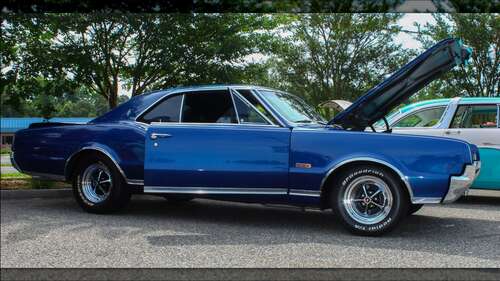
In 1965, the marketing confusion continued as the standard transmission in the 4-4-2 was a three-speed manual, but buyers could opt for a two-speed automatic or a proper four-speed manual. So, the PR department shifted (pun intended) the meaning of the 4-4-2 to refer to its new 400-cubic-inch V8 engine (producing 345 hp with 440 lb-ft of torque).
The following year, Oldsmobile offered a performance boost package on top of the 4-4-2 option package that seriously revved up the already powerful engine. Nothing confusing about any of that, right?
This W-30 performance option came with modifications starting with a triple-carburetor engine, a hotter camshaft, a unique cold air-induction system, and front bumper openings. The performance improvement was nothing short of dramatic. A 4-4-2 with the W-30 package won the C/Stock category at that year’s National Hot Rod Association drag races.
In 1970, GM finally dropped its ban on engine displacement size, and Olds could put a 455-cid V8 with 365 hp and 500 lb-ft of torque into the 4-4-2. The W-30 package increased the horsepower to 370 while also adding a fiberglass hood, an aluminum intake manifold, a reworked camshaft, an improved carburetor, functional air ducts, a low-restriction air cleaner, better heads, and a distributor.
The W-30 eventually turned into an appearance package, and by ’68, the hyphens in the 4-4-2 badging on the car were ditched yet stayed in marketing materials. Confusing until the end.

